As an eighties baby I fondly recall the bright, bold, fun illustrations that adorned products made for children; from puzzles and games to pyjamas, from wrapping paper to wallpaper. A lot of this design looks very much 'of it's time' now but I loved it then, as I imagine did so many others. The below 1980s paper demonstrates so well the imagination and attention to detail (the little mole's jumper-pun!) that struck a chord with children of that era.

In fact, one of the reasons I decided to design wallpaper for children's rooms was a discussion with a good friend in which she told me how much she adored her Brambly Hedge bedroom wallpaper as a child (Brambly Hedge is the beautiful creation of illustrator Jill Barklem, who's books about a community of industrious mice are still very popular today).
Wallpaper designed specifically for children became popular in Victorian Britain with the growth of the middle classes after the industrial revolution; an increasing number of families now had separate rooms for their children, and money with which to decorate those rooms. Designs were initially instructive in nature, intended to contribute to educational and moral development.
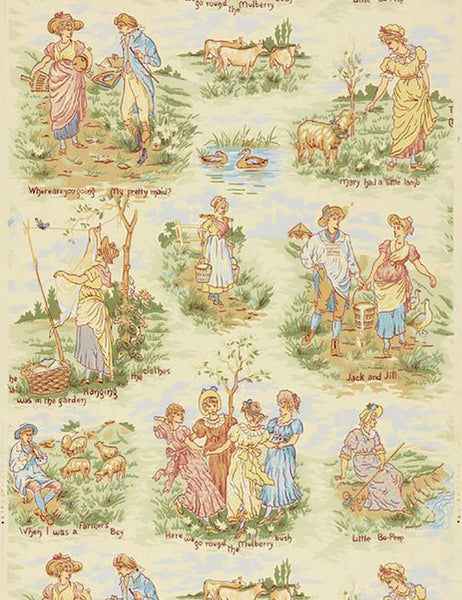
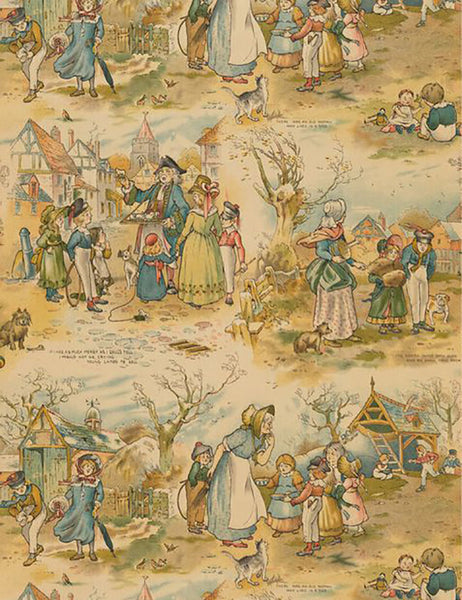

The three examples above come from the extensive online collection of Historic New England
The increasing popularity also ran alongside 'The Golden Age of Children's Book Illustration' (roughly 1860-1930) ushered in by such eminent names as Walter Crane, Randolph Caldecott, Arthur Rackham and Kate Greenaway, artists who elevated book images from mere decoration to story-telling vehicles in their own right.
Most children's wallpapers were derived from children's literature and indeed Caldecott and Greenaway allowed their illustrations to be adapted for the purpose, while Walter crane collaborated with London wallpaper manufacturer Jeffrey & Co, whose aim was to create wallpaper as art. (They also printed William Morris' wallpaper). Crane's designs contained much detail and narrative, yet started to move away from the instructional nature of designs for children, as people increasingly endeavoured to create nurseries that were comforting, playful spaces. This shift can partly be attributed to the Arts and Crafts movement, spear-headed by Morris, which promoted the social benefits of art and decoration.


Walter Crane nursery wallpaper designs, clockwise from top, Nursery Rhymes (held at the Cooper Hewitt Collection), Sleeping Beauty, The House That Jack Built.
Charles F. A. Voysey was another designer who was very influential in wallpaper design at that time and he created some of the most wonderful papers for children. Cleverly, he combined intricate, imaginative themes with sophisticated repeating patterns, ensuring the designs looked harmonious once covering a whole wall. I believe this is one of the reasons for their enduring appeal, indeed numerous designs can be purchased today from Trustworth Studios, and House of Hackney re-issued the brilliant Alice in Wonderland paper in 2016.

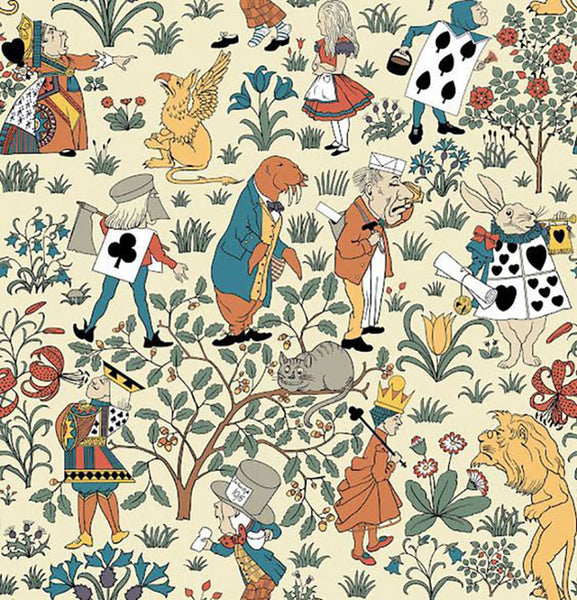
With the trend towards fun and playful nurseries came a raft of new papers in the early 20th century, with a whole host of themes and characters represented, from the genteel to the joyful.
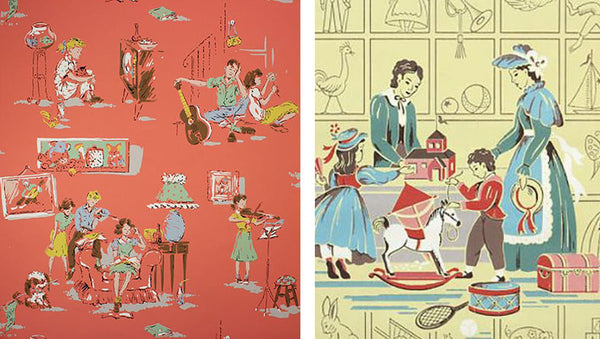



By the 1950s Disney got involved in wallpaper and the Peter Pan design below is one of my favourite vintage designs amongst those I have come across.




Inevitably, general trends in fashion, art and design impacted the designs of children's wallpapers and you can see so clearly the aesthetic trends of the time through them; bold colours and simplified shapes in the 1960s and early 1970s, and an array of colours and elaborate designs (and a little New Romantic flavour with the very popular Pierrot design - we had the duvet set!) in the late 1970s and 80s.






However, in the 1990s, with the advent of computer aided design and another aesthetic shift, this time away from the vibrant excesses of the 80s, wallpaper designs for children became much simpler and, in fact, paint was widely preferred. I noticed that a lot of papers from the 90s and early-to-mid 2000s employed simple repeats and often had little detail, perhaps due to the speed and ease of using a computer programme. Of course designs such as this have their place and can look great but it seemed a shame to me that there was a lack of imagination there. I believe that the detail and narrative quality of earlier designs is what made them so inspiring and memorable to children and that there is no reason why such magical designs can't be created now but with a contemporary aesthetic.
I'm happy to see that there is, again, a move towards imagination, storytelling and an appreciation of nature in design, which is being reflected in design for children, and hope that Renn Designs wallpaper contributes to creating magical, inspiring spaces for children to dream and play.
For an amazing selection of vintage wallpapers for sale see:
Hannah's Treasures
Rosie's Vintage Wallpaper
Coming up with a logo to represent your business can present a number of issues - do you try to convey what it is you do, or create? Do you choose something personal, or something that encapsulates your ethos? Fortunately, this task was made a lot easier for me owing to the fact that a Renn family logo already exists, although the family business is no more.

My paternal Grandad, Harold Arthur Renn, from Croydon in London, borrowed £100 from his mother-in-law (my Grandma, Irene's mother) to start his London-based business Renn's Shaped Ply, and used the image of the little Wren bird as his logo. I was lucky enough to find the above original 1949 advert online, from a vintage print shop, and bought it for £4 - not a bad price to pay for a bit of family history!
Before my grandad's business came to be, his father, a piano-maker, owned and ran Temple Pianos in Stoke Newington, Hackney, and during both World Wars his expertise in shaped wood was called upon to help develop wooden parts for fighter aircraft, using new plywood technology. His factory switched from making pianos to making propellors in WWI, and parts for the Mosquito aircraft in WWII - there was not such a call for new pianos during the wars anyhow! It was this new plywood technology - producing very light yet strong pieces - that led to Renn's Shaped Ply; furniture made in this way was an innovative product and the business grew quickly, with a factory just off Brick Lane in East London. Harold was able to pay back the £100 within a year.
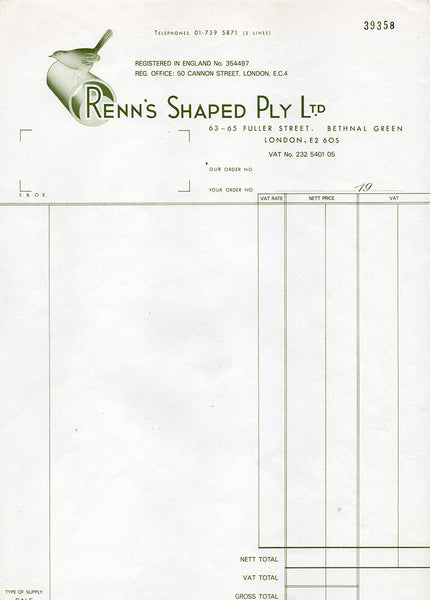
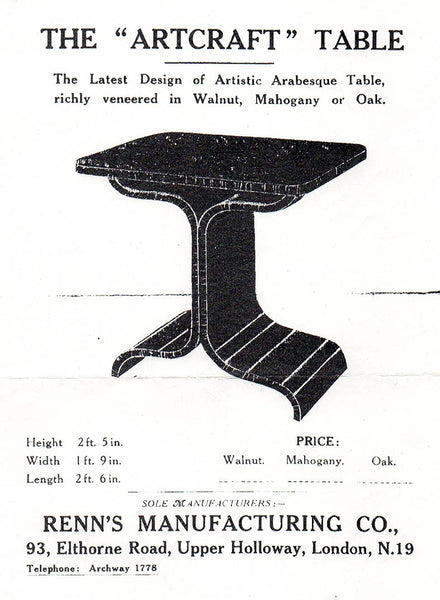
My Dad tells me that my Grandad was well liked as a boss, a sociable character, who happily employed people from all backgrounds, religions and ethnicities, at a time when this was often not the case. I found out recently that one of the Kray twins worked for him for a brief period, before they embarked on a life of crime...The factory experienced fluctuating fortunes over the years, like many businesses, and when the building itself was eventually condemned in the 1970s, Renn's Shaped Ply was sold.
My Grandad died two years before I was born, and so I have only known him through stories and photographs. It was a simple decision for me to use the little Wren bird for Renn Designs' logo, and the Renn family name, and I am happy that through this I can keep a little of the family history alive.

For as long as I can remember, my imagination has been totally captured by nature and the countryside, (despite never actually living in it) and it will always have a huge influence on my work.

As a child I loved looking at nature books before I was able to read them, going to the garden centre was a fun day out, and I would spend hours collecting shells on trips to the French Coast (my mum is French). I kept tiny snails temporarily as pets in an elaborate home I had constructed for them, and remember aged 11 or 12 walking home from school and buying myself a hyacinth plant from the local greengrocers; they are still one of my favourites but looking back, I don't think many children my age saw fit to spend their pocket money on perennial plants.

Picture books which depicted the countryside were also a constant source of wonder for me, and before I had really experienced much of it myself they provided endless inspiration for my childhood drawings - I spent A LOT of time drawing. Even an illustrated puzzle we had, of some mice playing in the garden of a thatched cottage, played a role in my decision that when I grew up I wanted to live in cottage with roses growing up the walls (this hasn't quite happened, maybe one day!) and many of my drawings consisted of cosy, country scenes. I pretty much wanted to live in Brambley Hedge or by The Riverbank with Ratty and Mole!


Below are illustrations from some of my favourite picture books set in the countryside. (The Lovely Present, Maurice Sendak; Wind in the Willows, Kenneth Graham, illustrated by Inga Moore; The Four Seasons of Brambly Hedge, Jill Barklem).
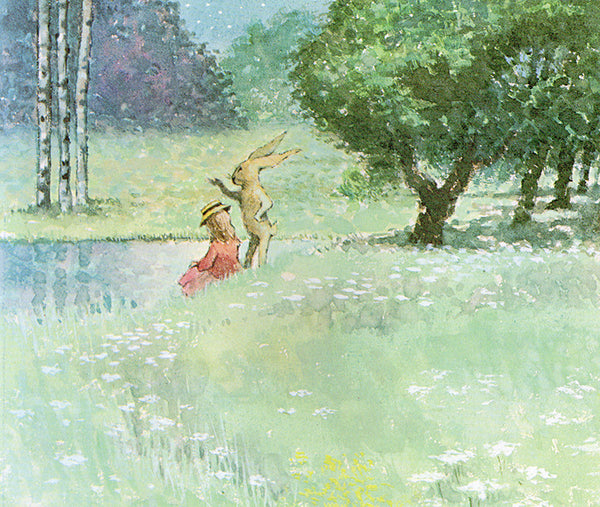



Naturally, my love of nature regularly surfaces in my work. Peonies were my favourite garden flower as a child so I happily included them in my Thumbelina - a fairytale by Hans Christian Andersen - inspired children's wallpaper, along with fritillaries (and more) which featured in a botanical colouring book I was given, many years before I saw some in reality at a Royal Horticultural Society show. Renn Designs Big Cats wallpaper is full of tropical plants I have seen on my many visits to the wonderful Kew Gardens.


While working in a book shop a few years ago, I bought a battered book in the sale for 99p called The Sky and the amazing Northern Lights photographs inspired me to create my Northern Lights children's wallpaper, in which I wanted to capture some of the beauty and magic of nature and Space.

A happy customer and lovely friend sent me this wonderful photo of her son appreciating his Northern Lights wallpaper in his bedroom. She said he notices something new every day and I very much hope his young imagination has been captured by my design, in the way that mine was, and still is, by nature and beautiful depictions of it.







































